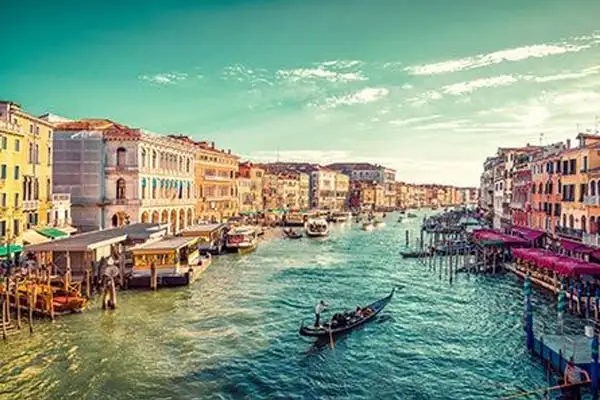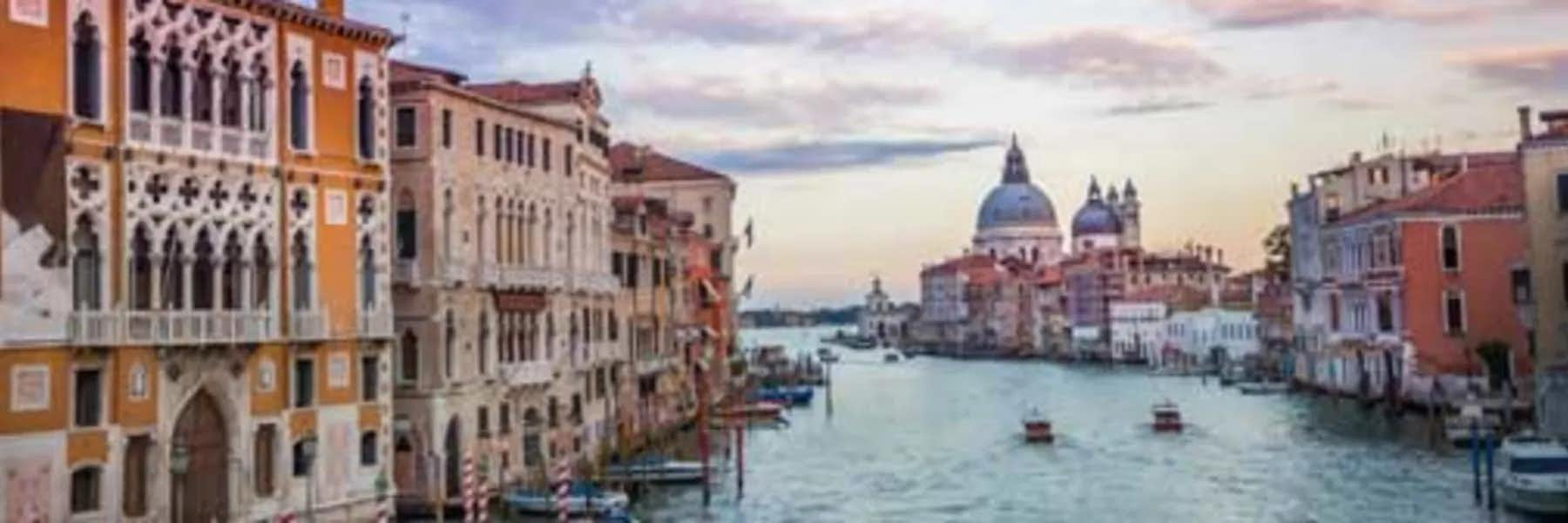By Sylvia Kholti
Canals, gondolas, dream-like palaces, romantic little piazzas—and not a car in sight. Venice is a must-see destination for anyone visiting Italy. And despite the city’s expensive reputation, there are several ways to keep your budget under control while you’re visiting. To me, it’s not merely about saving money. It’s about being more authentic and trying to live as the locals do.
Here’s some handy tips to help you save some money and experience more of the local lifestyle in the process.
Best Seasons to Visit Venice
The best time to visit Venice is definitely early autumn or spring. Summer time is lovely, but it can also be extremely exhausting: partly because of the large crowds of tourists and partly because it’s much more tiring to climb all those stairs and bridges when it’s hot. Winters in Venice are regularly mild, but apart from the Venice festival season in February, I wouldn’t recommend visiting at that time of year.
Traveling to Venice

Venice is served by two international airports: Marco Polo Airport and International Airport Treviso A. Canova (TSF). Both airports have a good transfer system. From Marco Polo, the bus takes about 15-20 minutes (depending on traffic) and from Treviso, it's about 30 minutes longer. The city is also served by a large international railway station and a bus station. Cheap flights are also available from larger European cities, like London, Paris, or Brussels.
Get Your Free Italy Report Today!
Get Your Free Italy Report Today!
Learn more about Italy and other countries in our daily postcard e-letter. Simply enter your email address below and we’ll send you a FREE report – Italy: Europe’s Most Seductive Country.

By submitting your email address, you will receive a free subscription to IL Postcards and special offers from International Living and our affiliates. You can unsubscribe at any time, and we encourage you to read more about our Privacy Policy.
Stay in Mestre Instead of Venice
It’s a lot cheaper and more convenient for those traveling on a tight budget to stay in Venice's mainland suburb of Mestre. Close to the airport, and a short bus, train, or tram journey away from the island, Mestre is a lovely town in its own right. I personally love its fish market, which is an absolute must-see, especially on Wednesdays and Fridays when it’s market time and the city center turns into one giant marketplace.
Check Out the Campsites
I always choose to stay at a campsite when I visit Venice. One week in a campsite generally costs around the same as one night in an elite Venice hotel. My favorite campsite is called Camping Village Jolly. It has a beautiful swimming pool, a lovely restaurant, a supermarket, laundry, and air-conditioned bungalows with bathrooms. In addition, the nearby bus station offers a convenient bus transfer straight to Venice for a mere €1.50 ($1.80). If you want to have a low budget holiday and still have a great time, this is the way to go.
Use Public Transportation
The Venice Tramway is by far the easiest and cheapest way for you to travel around the area. The trams are air-conditioned and also stop by the Mestre railway station. You can buy tickets for €1.50 ($1.80) one-way, which is the same price as the bus. The final stop is Piazzale Roma, the central bus station and principal arrival point in Venice. It also caters to international and long-distance buses from all across Italy.
Where to Eat in Venice
It’s no surprise that most of the Venetian restaurants focus on tourists and therefore they are very expensive. This means that a standard meal with wine would cost around $100 to $150 for two people. However, there are a lot of restaurants that offer a daily menu for a decent price, especially in the lesser visited areas. If you choose one, be mindful of the service fee or coperto.
I’d also suggest trying one of the growing number of bakery shops in Venice. You can sit down, have a cup of coffee or some good quality food (pizza, sandwiches, and any bakery products) for a fraction of the price of some of the other eateries. Or you could visit one of Venice’s supermarkets and save plenty of money. But it’s worth noting that there are no supermarkets around the railway/bus station area and it’s about a 10-minute walk along the main tourist route leading to San Marco Square before you run into a large Co-op (a supermarket chain found all over Italy). If you stay in Mestre, you will notice that supermarkets are much cheaper there than in Venice.
Take Advantage of the Free Attractions

There are several churches and even museums that don’t have an admission fee but still give you that authentic feeling and experience of seeing something historical, unique, or otherwise interesting. Churches, for instance, generally don’t ask for an admission fee and often house various sorts of arts exhibitions which you can check out. The beautiful Basilica di Santa Maria Della Salute, one of the largest churches in Venice, is the one that stands out for me. Just a short distance from the church, you can catch some of the most spectacular views of Venice from the sea (as it’s located right at the southern cape of the island where the Grand Canal runs into the sea).Tips to Navigate Venice Like a Local
By Rebecca Hughes

Venice is a sight everyone should see at least once in their life. Gondolas weave through a maze of canals, while the dappled reflection of sunlight highlights ornate Renaissance footbridges.Polished teak water taxis tie up in front of 15th-century palaces, dropping wide-eyed visitors into the elegance and bustle of St. Mark’s Square. Beauty, history, and a confident Italian swagger are everywhere, from the casual style of locals enjoying a ristretto (a short, concentrated espresso) at a sidewalk café to the vibrant Titian frescoes on chapel walls.
Tarnished by horror stories of $18 coffees and $600 restaurant bills, the city’s reputation for being expensive has a kernel of truth. It can be costly. Nevertheless, with a little local knowledge and some insider tips, you can enjoy the city for less than you ever imagined.
Indulge In Some Free Sightseeing
Venice surprises visitors by offering many of its most famous sights for free, including Piazza San Marco, the Basilica of San Marco, and the Bridge of Sighs. And on the first Sunday of every month, state museums cost nothing to enter.
Alternatively, you can find world-class art by peeking into almost any church that takes your fancy. One of my favorites, Santa Maria dei Carmini, is free and contains paintings by a young Tintoretto. One of the richest churches for art, despite its plain exterior, is Santa Maria Gloriosa dei Frari. It houses Titian’s majestic Assumption of the Virgin, as well as a wooden sculpture of St. John the Baptist by Donatello. Entrance is $4.
For a panoramic view, I love to visit the free roof terrace of the Fondaco dei Tedeschi, a luxury department store. You can easily book your 15-minute slot online. Visitor Judith Standen says, “We timed our visit for sunset and spent 15 minutes gazing at this impossibly beautiful city and the Grand Canal, tinged red and orange.”See: Dfs.com/en/venice/t-fondaco-rooftop-terrace.
Getting Around on a Budget
Venice’s canals are not just pretty, they’re the thoroughfares of the city. Most locals use the vaporetto water buses for everyday transport. They’re affordable transport, with the added benefit of getting you to parts of the city most tourists never get to. If you plan to visit islands like Burano, Murano, or Chioggia, a vaporetto three-day ($50) or seven-day ($75) pass is a good investment (a single ticket costs $9.30).
You can use the vaporetto n.1 or n.2, which chug down the Grand Canal, as a cheap tour bus. Or pop over to Isola di San Giorgio Maggiore (vaporetto n.2, stop San Giorgio), where entrance to the Palladio church is free; it contains two late paintings by Tintoretto. The adjacent bell tower provides a cheaper alternative ($7.50) to climbing St. Mark’s campanile. You see Venice as it really is—an aquatic city floating like a mirage on the water—as opposed to the urban view from St. Mark’s.
Gondola rides are expensive and commercialized, but you can experience an authentic locals’ version for just $2.50. The Grand Canal traghetto—a large gondola rowed by two standing oarsmen—ferries passengers across the canal at Campo Santa Sofia. Locals stand up on the crossing, but personally, I’m happier perching on the gunwales to avoid embarrassing rescue operations.
Affordable Food That Actually Fills You
“Venice on a budget” advice often recommends skipping restaurants and visiting traditional bars for cicchetti (Venetian tapas). However, as any Italian will tell you, this aperitivo food is not intended to fill you up. In fact, with cicchetti costing $1 or $2 a mouthful, a satisfying meal can get costly. For proper (filling) lagoon fare at reasonable prices, head to the fishing town of Chioggia, just south of Venice.
The scenic, if slightly tortuous, route requires taking the vaporetto n.1 to the Lido, then the mixed bus/vaporetto line 11 to Chioggia. The trip takes about 90 minutes. Visit Da Nicola, a traditional canal-side osteria with a simple modern interior and a chef who comes to your table to tell you what’s fresh that day, at $12 to $18 a main. If it’s in season, try the moleche, deep-fried little crabs, which are a specialty of the Venetian lagoon.
Good-Value Accommodation Options
Good-value accommodation is not impossible to find in Venice. For 18th-century Venetian elegance, try the Ca’ Dogaressa in the Cannaregio district. Its brocaded rooms with Murano glass chandeliers start as low as $85 in off season and $165 in high season. In summer you can enjoy breakfast by the canal and relax on the roof terrace. Hotel Rosa Salva is located very close to St. Mark’s and boasts the rare quality of spaciousness. Rates start from $125 in low season and $185 in summer. For travelers on a tighter budget, try the We Crociferi hostel in the Cannaregio area, located inside a restored convent. Double rooms range from $70 to $135. Although basic, there is a beautiful arcaded cloister and a stylish, spacious bar area.
Get Your Free Italy Report Today!
Get Your Free Italy Report Today!
Learn more about Italy and other countries in our daily postcard e-letter. Simply enter your email address below and we’ll send you a FREE report – Italy: Europe’s Most Seductive Country.

By submitting your email address, you will receive a free subscription to IL Postcards and special offers from International Living and our affiliates. You can unsubscribe at any time, and we encourage you to read more about our Privacy Policy.














